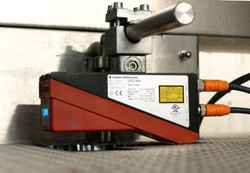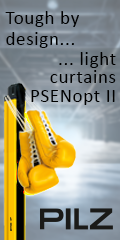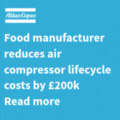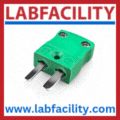
Posted to News on 18th Dec 2014, 16:30
Quality control with LRS 36 light section sensors at dairy
The Gropper dairy is well known for its fresh ideas made of milk - after all, the ambitious employees at the innovative dairy in Kesseltal (Bavaria, Germany) love everything to do with milk. Jrgen Kreutz from the Electrical Maintenance department at Gropper had been looking for a "fresh" idea of a different sort for the so-called full-crate check at the end of the cup production line. His idea of solving this task using LRS 36 light section sensors from Leuze electronic reduces the number of sensors, simplifies the application, saves manual conversion required due to the frequent format changes and makes this particular step in the quality assurance procedure more reliable.

Apart from classic milk products such as yoghurt, cream, fresh milk, desserts and coffee specialties, the 500 employees at the Gropper dairy, founded as a cheese dairy in 1929, produce everything that has to do with milk. Furthermore, the company is a reliable service provider for filling and logistics in the co-packing branch.
By far the largest business segment is, however, the production of brand names with all milk-based product variants. As one of the most renowned German manufacturers in this sector, Gropper produces a wide range of products for German discounters and supermarkets, but also for internationally active trading companies.
Gropper utilises its decades of experience and wealth of fresh ideas to continuously develop its products. Efficient filling machines and the latest process technology make it possible to offer a diverse range of goods. Jrgen Kreutz, deputy manager of the Electrical Maintenance department at Gropper explains: "This diversity which is also reflected in the wide variety of packing materials in the form of bottles, cartons or cups cannot be precisely quantified, first and foremost because sometimes products are manufactured only once as a special offer in specially designed packaging." As a result, the filling systems require a high degree of flexibility and the Maintenance department, which is comparatively large for a company of this type, is permanently occupied with the technical development and improvement of the systems.
In certain areas, for example at the end of the so-called cup lines, this diversity presents a real challenge. Here, yoghurts, desserts or beverages are filled in cups with diameters from 75 to 95mm and filling quantities from 80 to 500g. The design of the cups ranges from classic yoghurt cups with foil lid to versions with additional snap-on lid. Mr Kreutz explains: "At the end of these systems, which incidentally each fill up to 40,000 cups per hour, we have installed testing applications to check that the crates leaving the system have been completely filled."
Frequent format changes
Owing to the diversity and the frequent format changes, complex manual conversions were necessary here to align the respective sensor combinations. Corresponding to the number of cups per row in a crate, each sensor combination consisted of five sensors in the case of standard crates. Mr Kreutz adds: "In addition, reliable detection was not guaranteed with certain cup designs, in particular cups with clip-on lid, owing to the strong reflections produced."
Neither light scanners nor ultrasonic sensors could achieve the desired reliable results. After trying out various installations with different systems, a visit to the Leuze electronic stand at a trade show gave Mr Kreutz a fresh idea, that is, to use light section sensors of the type LRS (Line Range Sensor).
Similar to a laser scanner, light section sensors detect the presence of objects by scanning. A single LRS 36 sensor is able to detect one or more objects in an undefined position. A special advantage is that the transmitter and receiver are integrated in a compact housing.
With their large scanning area of 200 to 800mm, the LRS 36 light section sensors are well suited for Gropper as they allow for the format changes, such as height differences of the cups in the cup lines, without the need for mechanical conversion. In total, up to 16 inspection tasks each with up to 16 analyses are available and can be configured using a PC via an Ethernet interface. "To check our standard crates, with five cups in a row, we need just one inspection task with five analysis windows", confirms Mr Kreutz, for whom the LRS 36 sensor offers sufficient flexibility for other crate formats.
A full-crate check begins with the signal from an additionally installed trigger photoelectric sensor which points at the crate. The light section sensor determines the measurement results at a frequency of 100Hz for as long as a signal from this photoelectric sensor is present (i.e. for as long as a crate is being detected). In each measurement, the pixels inside the five analysis windows are recorded. Data calculation and processing occur directly inside the sensor. The analysis result for the switching windows depends on the freely configurable upper and lower switching limits. Finally, the results for the five analysis windows are logically linked to each other and assigned to a switching output.
At Gropper, the light section sensor forwards a digital signal to the higher-level control system in the event of an incorrect measurement. Up to six switching outputs are available. To ensure that the small gaps between the cup rows in which no pixels are generated are not interpreted as error messages, a debounce time (switching delay) was set up on the control system. Only a series of incorrect measurements lasting a certain period of time is interpreted as a missing cup and causes a crate to be detected as a faulty crate and then to be ejected.
Simple integration
Mr Kreutz concludes: "The analysis process in the light section sensors saves us five outputs and the time otherwise required to configure the PLC at the machine." He is particularly pleased with the large scanning area of the LRS 36 sensors because it makes completely unnecessary the mechanical conversions otherwise required to adapt the system to different cup heights in the case of format changes. Furthermore, instead of the sensor combinations that were previously required, just a single sensor is now sufficient for all five cups in a row.
What Mr Kreutz also likes about the LRS 36 light section sensors from Leuze electronic is their simple integration in existing machines. This applies to mechanical connection as well as electronic integration and configuration. The sensors are easily mounted using their dovetail attachment. He syas: "We no longer need complicated adjustable mounting brackets that have to be designed and made in advance for each of the individually configured cup lines." He also welcomes the compact design of the LRS 36 sensors, which makes integration in the filling systems easier. The light section sensors are configured using the LRSsoft software developed by Leuze electronic and the configuration process itself is performed by the Maintenance employees at Gropper.
According to Mr Kreutz, practical experience has shown that the LRS 36 has a comparatively good compatibility with the sometimes very aggressive cleaning agents used at Gropper. What he also finds particularly important is the absolute reliability in the detection of the cups, even the problematic variants with clip-on lid.
To learn more about LRS 36 light section sensors from Leuze, please visit www.leuze.co.uk.
1B Fenice Court
Phoenix Park
Eaton Socon
PE19 8EW
UNITED KINGDOM
+44 (0)1480 408500






